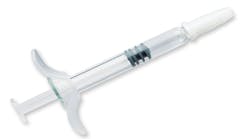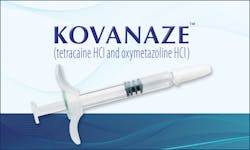The St. Renatus clinical team answers our questions about Kovanaze, the first FDA-approved no-needle regional, pulpal anesthetic administered via nasal spray
Kovanaze has the potential to revolutionize anesthesia delivery in dentistry. What are the most important things dentists should know about nasally-administered Kovanaze?
Kovanaze provides regional, pulpal anesthesia with 96% efficacy in teeth Nos. 5–12, therefore Kovanaze offers a needle-free alternative to the majority of anterior maxillary injections.
Additionally, patients may not experience the same sensations of numbness or tingling of the lips and cheeks associated with injectable dental anesthetics.
Kovanaze is the first no-needle regional, pulpal anesthetic administered via nasal spray to be approved by the US Food and Drug Administration (FDA), and it offers patients a safe and effective, needle-free alternative to anesthetize teeth 4-13 for restorative dental procedures.
What are some of the key concerns dentists have had about Kovanaze, and how have you addressed them? (e.g., effectiveness, contraindications, etc.)
As with any new drug, practitioners are initially most concerned about safety and efficacy. The FDA approval process for Kovanaze, which extensively examined both the safety and efficacy of Kovanaze in clinical trials, helped us address these concerns.
The well-established safety profiles of tetracaine and oxymetazoline (the active ingredients in Kovanaze), along with their decades of use in the marketplace, can help assure dental professionals and patients of Kovanaze’s safety.
Furthermore, the clinical trial data demonstrating 96% efficacy in anterior maxillary teeth (Nos. 5-12) speaks directly to practitioner concerns about efficacy. Through our dental education efforts we are confident that dental practitioners will quickly become comfortable with Kovanaze safety and efficacy and look forward to bringing this new technology to their patients.
What procedures can Kovanaze be used for?
Kovanaze provides regional anesthesia for restorative procedures performed in teeth Nos. 4-13.
Can you summarize patients’ reactions to Kovanaze?
Both patients and practitioners involved with our clinical trials expressed great excitement over the possibility of having a needle-free alternative for anesthetizing the majority of maxillary teeth. For more than 100 years, the dental industry has delivered dental anesthesia using a needle injection. Now, through the efforts of a dedicated team, we have developed a revolutionary needle-free method for delivering pulpal anesthesia. We believe this advance will be good for patients, practitioners, and dentistry as a whole.
ADDITIONAL READING:Kovanaze’s clinical development: An interview with St. Renatus CEO Steve Merrick








